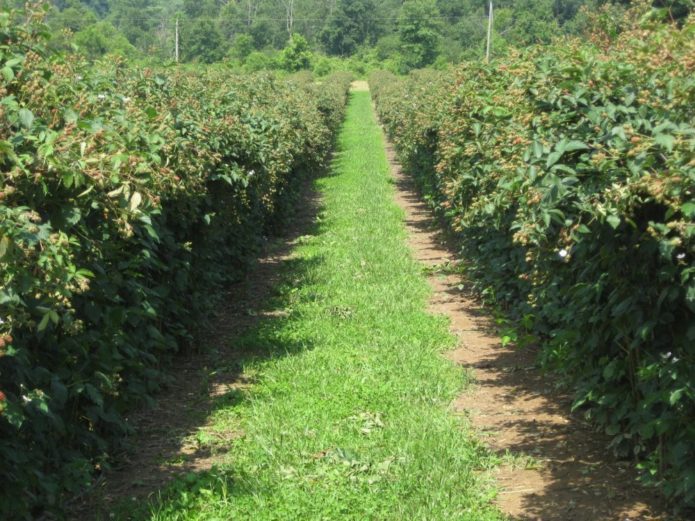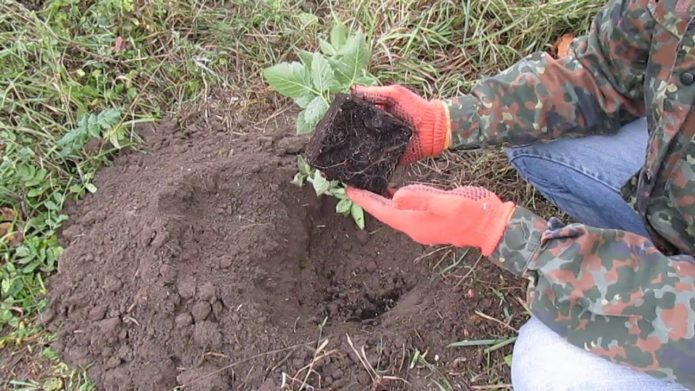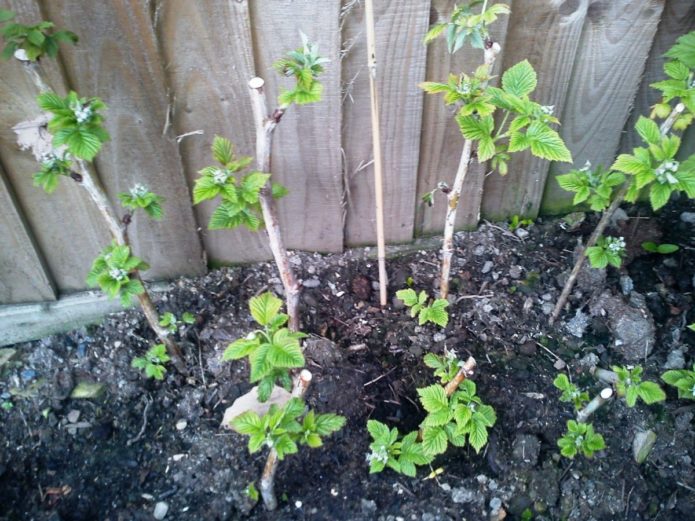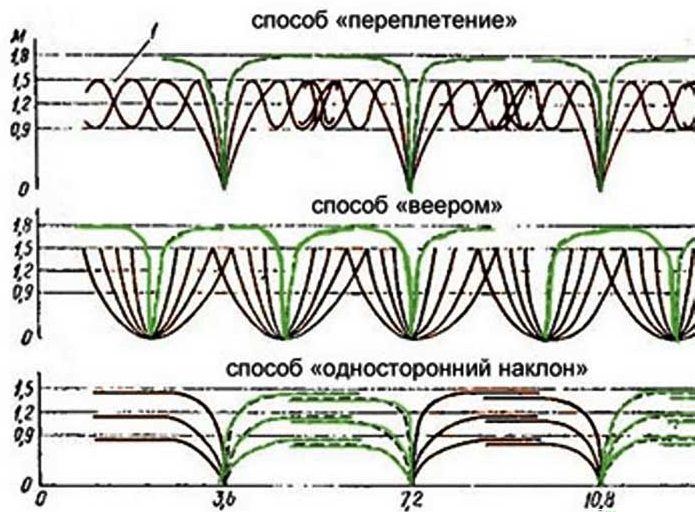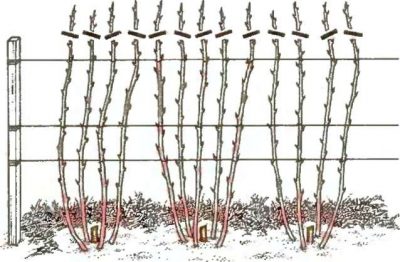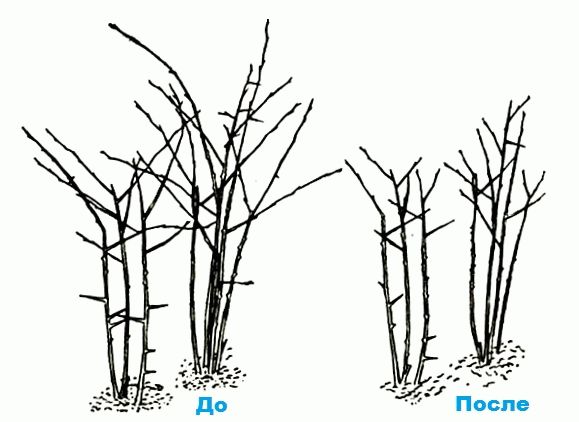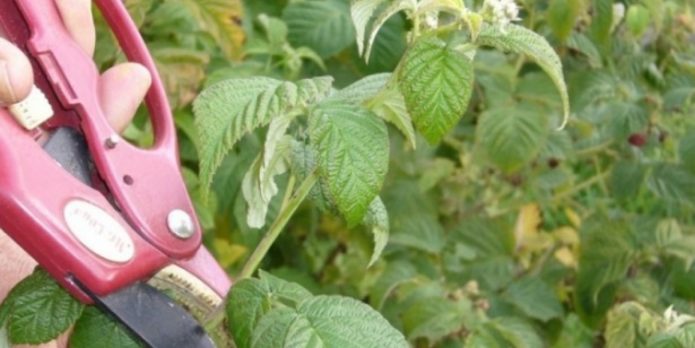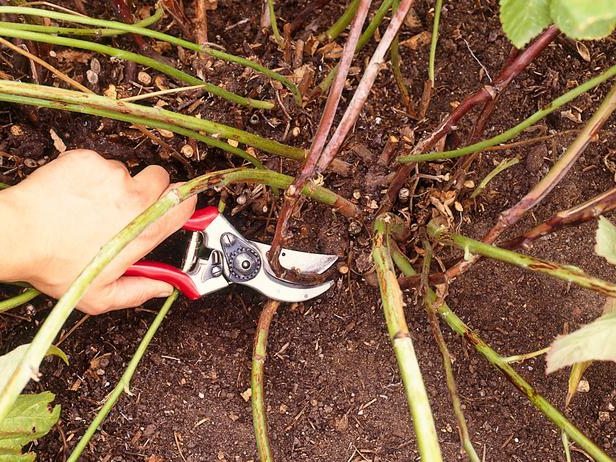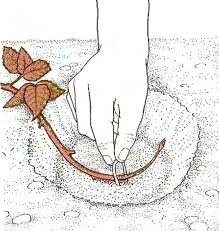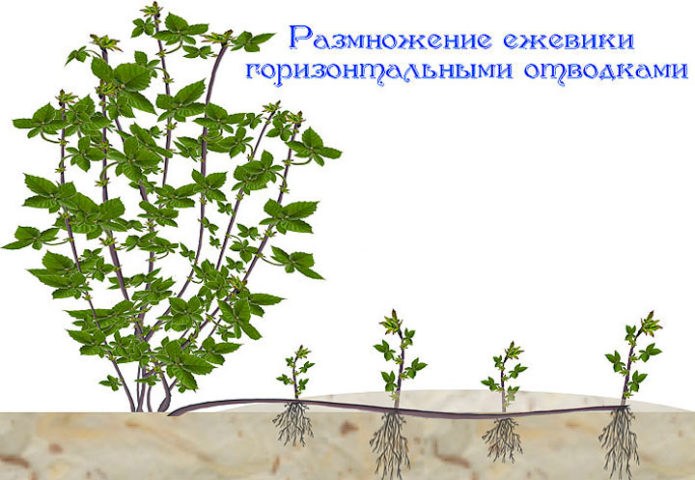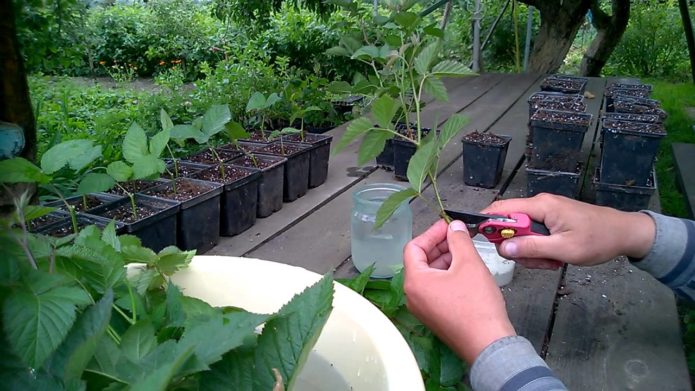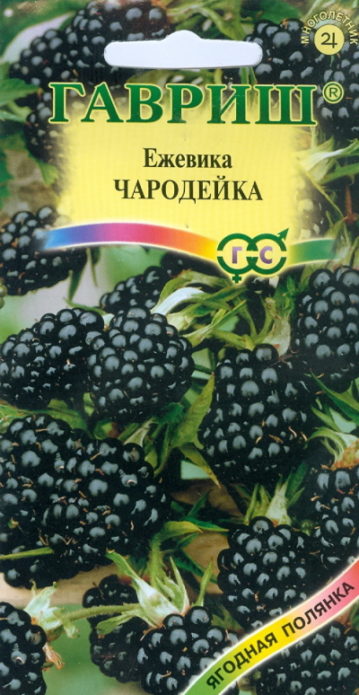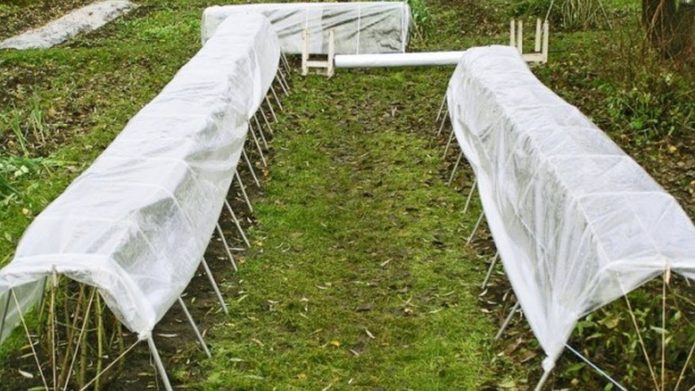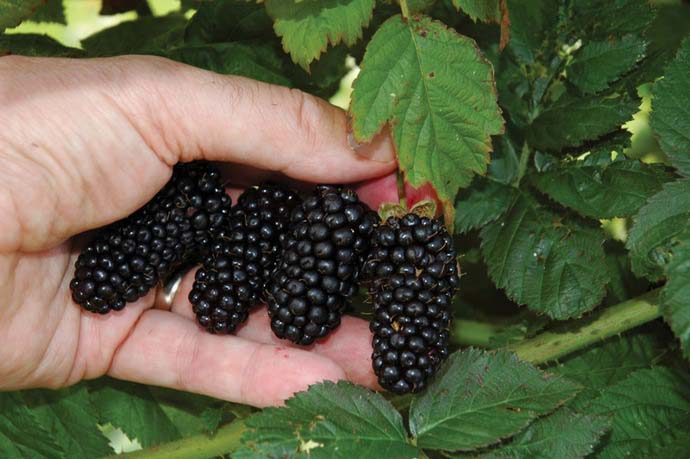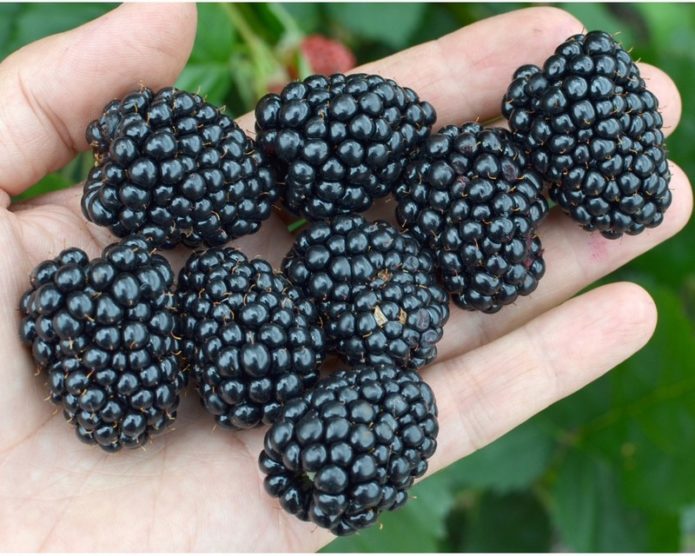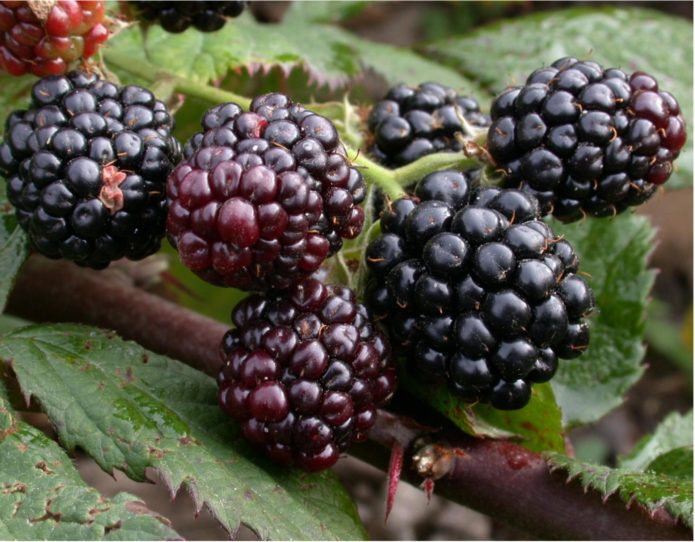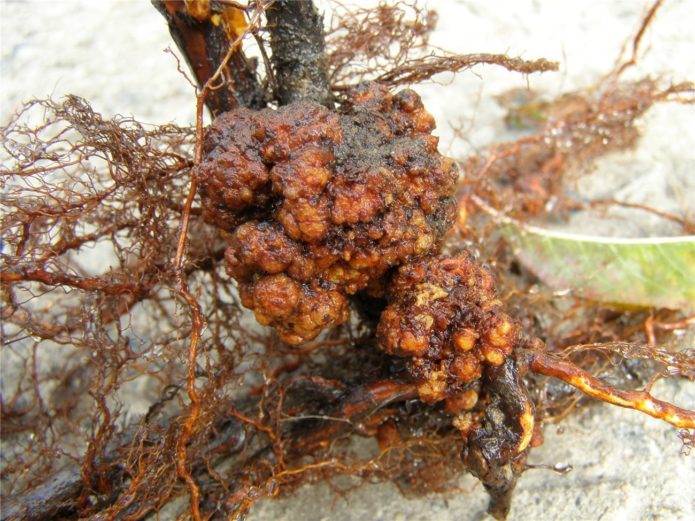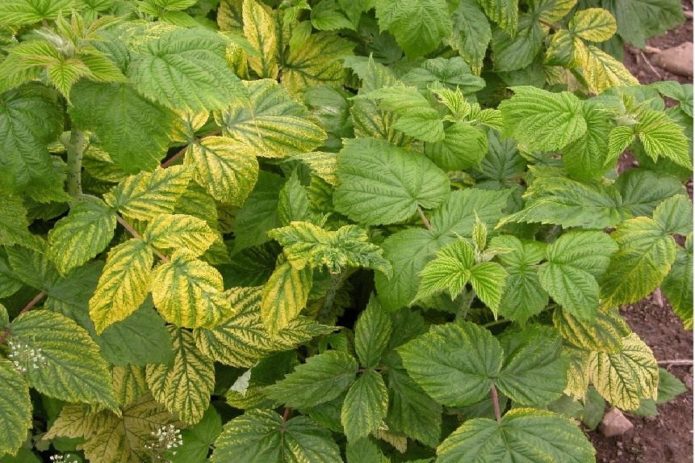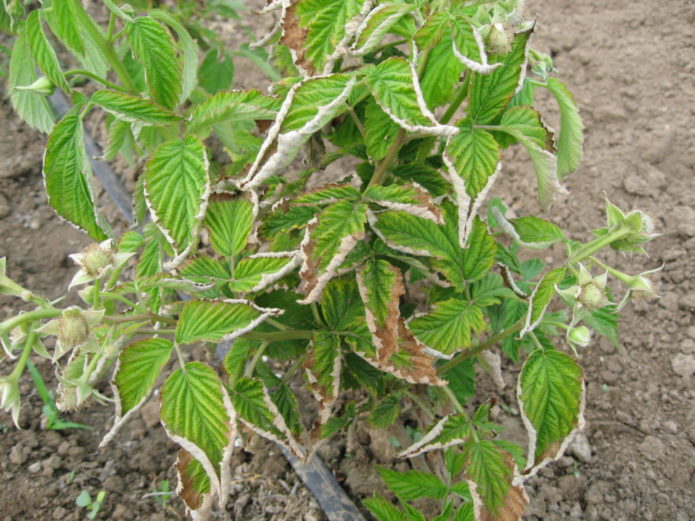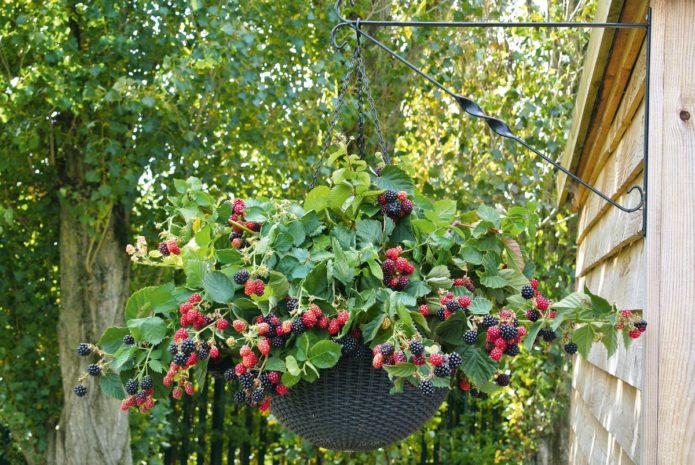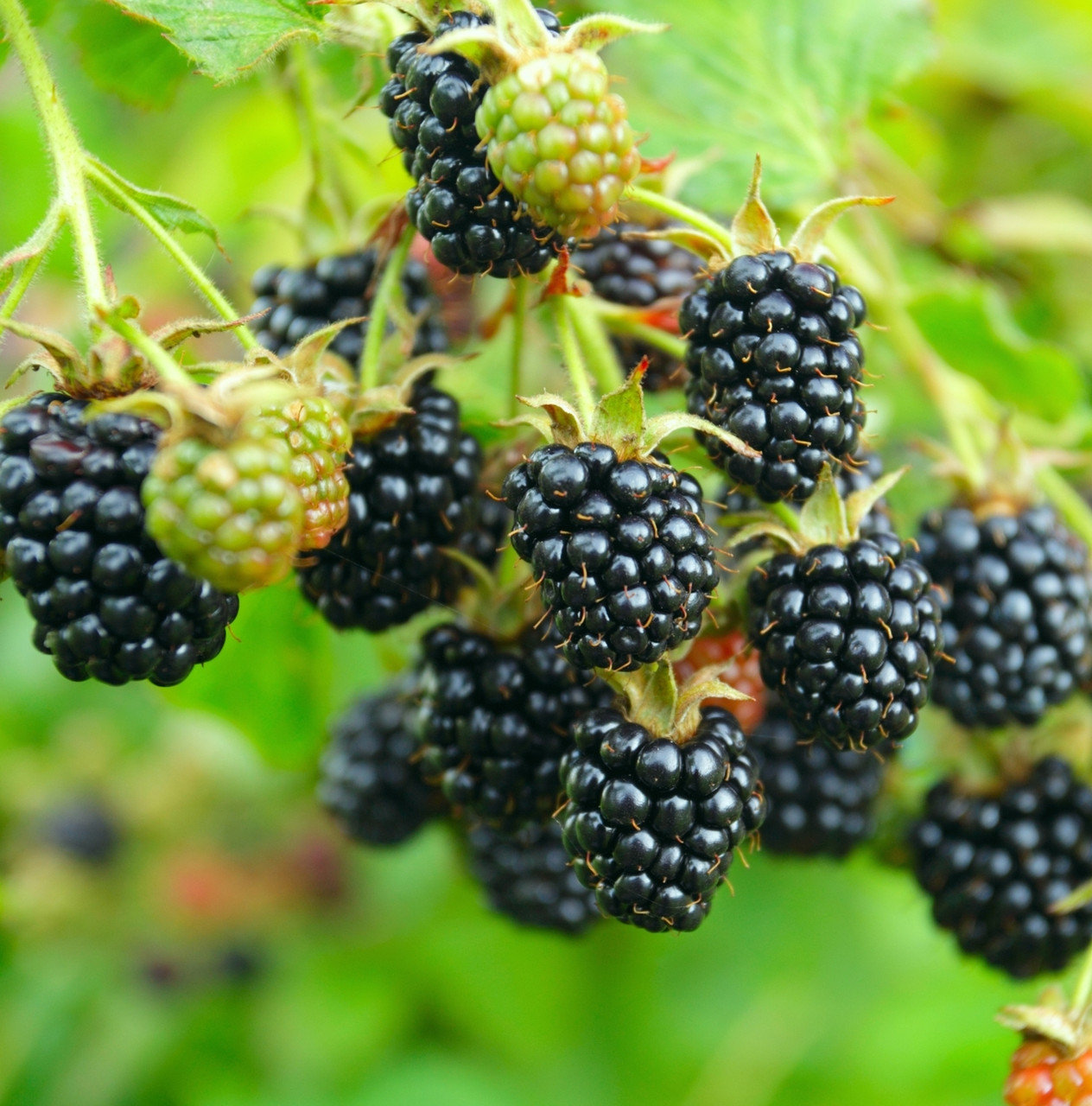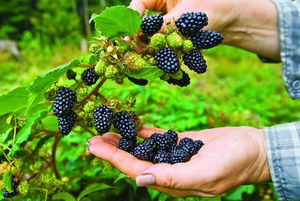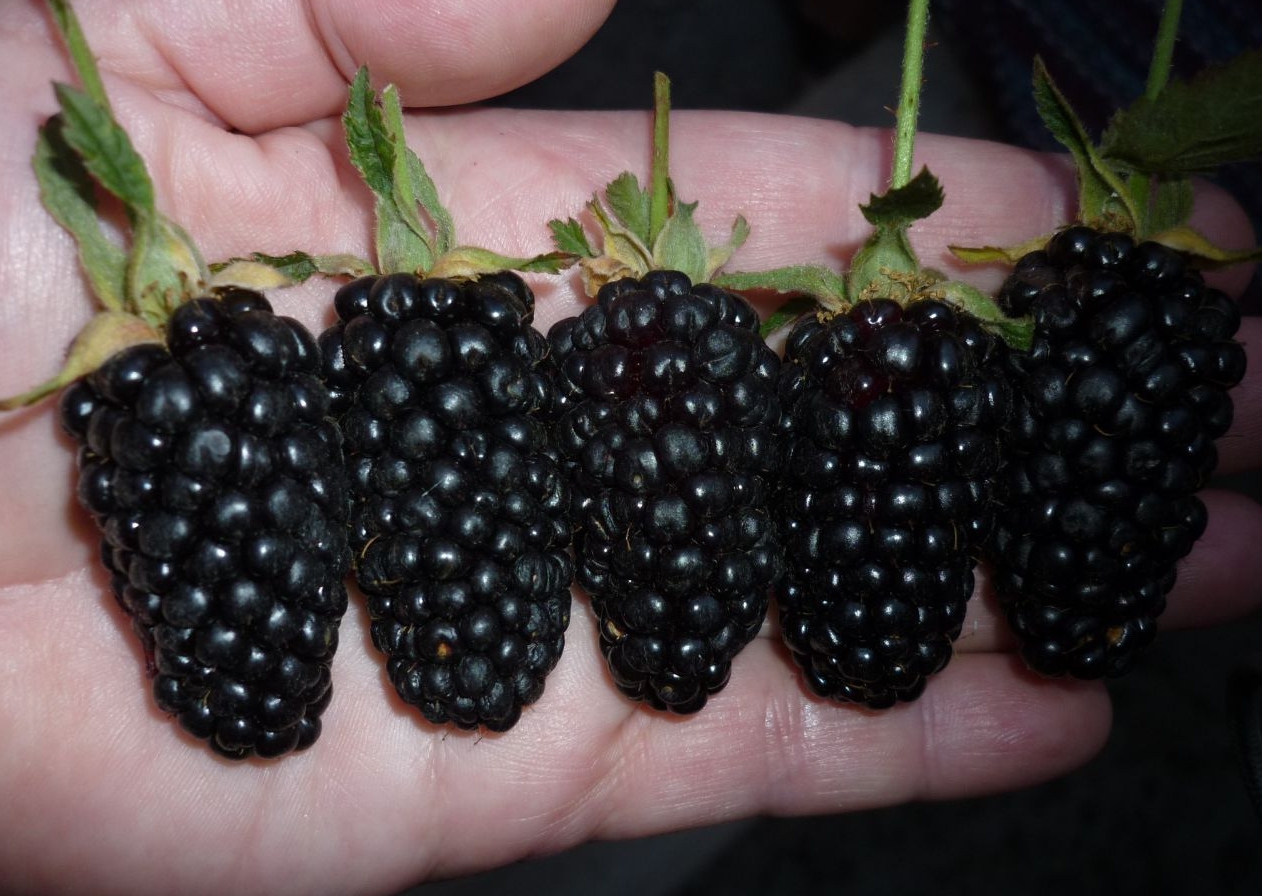Blackberries are rarely seen at the dachas of Russians; many prefer raspberries to it. But these berries are so different! It is worth planting both on the site. Blackberries are thermophilic and need shelter for the winter. But under a reliable "blanket" no frost is terrible for the bushes. Even the Siberian.
Content
We plant blackberries correctly
In order for the blackberry to please with the harvest every year, you need to plant the plant correctly.
Seat selection
You need a sunny place for planting; in the shade, blackberries almost do not set berries. In the south, light partial shade or shade during hot daytime is better. Blackberries do not grow on swampy soils.
Bushes need space. Leave 3 m between the rows. The distance between the bushes depends on the variety and climate. But to the question of whether it is possible to plant blackberries next to raspberries, the answer is unequivocal - no. And it's not that these crops have common pests. The danger lies elsewhere. In raspberries, the roots grow in all directions, and after a couple of years, raspberry shoots can grow in the zone of the blackberry roots.
You cannot plant blackberries in a place where raspberries grew before.
Planting pit preparation
The roots, unlike crimson ones, go to a depth of 80 cm.Therefore, planting pits, even in fertile areas, are made 60 cm deep and 70 cm in diameter.
Spring planting pits are prepared in the fall.
If the soil on the site is clayey, sand or peat is added to it. A bucket of compost is poured onto the bottom, with which a glass of sifted ash is thoroughly mixed. Then they pour in fertile soil, also mixed with ash. During the winter, the soil will settle.
Blackberries do not like acidic soils. Therefore, if there is no ash, chalk or dolomite flour is added to reduce acidity on acidic soil: 200 g per plant when preparing the pit, and later - half a glass per year per plant.
A blackberry bush can grow in one place for 10-12 years.
Landing features
You need to purchase seedlings for spring planting either with a closed root system, or on site in a nursery. The kidneys should not be swollen.
Planting a seedling with a closed root system:
- Seedlings in a container are stored in a cool, lighted place until planting.
- Before planting, the soil in the container is spilled in order to effortlessly remove the earthen lump.
- A seedling with a clod of earth is placed in a hole without deepening.
- The remaining voids are covered with earth.
- Pour 10 liters of water.
- After planting the seedling, the trunk circle is mulched (half a bucket of humus or compost is added and leveled without compaction).
Planting a seedling with an open root system:
- Seedlings with exposed roots should be planted as soon as possible.Before that, it is advisable to pour them with a solution of the drug Kornevin.
- If rooted cuttings are transplanted from their own greenhouse, it is important not to disturb the earthen ball and to deepen the seedlings a couple of centimeters compared to how they grew before.
- No more than four buds should be left above the soil surface. Everything that is above is cut off, and the cut is immediately lubricated with garden varnish or wax heated to viscosity.
- Seedlings are watered and mulched.
The need for a trellis
It should be borne in mind that the grown shoots must be tied to a trellis - a wire stretched between the supports in several rows. They are made so that the bushes are illuminated by the sun all day. The trellis is installed with a height of 2 m.On flat areas, the bushes are oriented so that the rows turn out in the north-south direction.
For beginners or experienced gardeners who first encountered blackberries, it is useful to know some secrets of planting and transplanting them:https://flowers.bigbadmole.com/en/yagody/posadka-ezheviki-vesnoy.html
Forming a blackberry bush
The type of structure of the bush is distinguished:
- dewberries - creeping like wild blackberries,
- kumaniki - tall, raspberry-like,
- remontant, which bear fruit on young shoots.
It is believed that creeping blackberry varieties are less resistant to frost. But this does not mean that they should not be planted in cool regions, rather the opposite. After all, it is easier to remove a flexible vine from the trellis and lay it on the ground than to cover a tall bush.
The formation of a bush is an important element of blackberry farming. Nuances of the process:
- At a height of 2 m, the tops of the heads are pinched. Excess shoots are removed immediately
- Tall varieties (kumaniki) do not need a garter. It is customary to trim them, not pinch them. If you pinch, the shoot will begin to grow in the upper part, and after pruning, side branches will appear. This is done in June, the shoot height should be 70 cm or more, the top is cut off by 10-12 cm.
- 3-4 young shoots are left on the bush, the extra ones are plucked out below the ground level. Sick, weak and severely affected by pests are also removed without delay.
- In the middle of summer, the ends of the lateral branches are trimmed (by 8-10 cm).
- After collecting the blackberry, the sprouted shoots are cut out without delay, so the bushes will be better ventilated.
- In the spring, the ends of the shoots are cut by 1–2 cm.
- The tool must be sharp and clean.
In adult bushes of remontant blackberries, the number of shoots is limited, removing excess, diseased and broken ones. You don't need to pinch or trim anything. For the winter, all the stems are cut at the base, so it is easier to cover them than other species. But for regions with a short summer, remontant blackberries are not suitable.
Blackberry without thorns
It is much more pleasant to care for blackberries without thorns. And it is more difficult to reproduce it. Stem cuttings of such varieties take root worse, and more often plants with thorns grow from root shoots.
Some gardeners claim that thornless varieties are less frost-resistant, but this is not confirmed.
Disease resistance in thornless varieties is higher. But slugs and snails are afraid of thorns, and feel great on smooth stems. Among other pests, the bear and the beetle larvae are dangerous. Since they do not sit on the branches, it is not easy to notice their appearance. To protect against the bear, a poisoned bait is laid out near the bushes in spring and autumn (a little, so as not to lure the pest from neighboring areas). It is recommended to use biological products from the larvae of the beetle, for example, Boverin. It is harmless and, when used correctly, has an excellent effect. Antichrusch is also suitable. The insecticide is applied during planting along with humus.And since the first harvest is obtained 1.5 years after planting, there will be no toxic substances in the berries.
The best varieties of thornless blackberries and the peculiarities of their cultivation:https://flowers.bigbadmole.com/en/yagody/sorta-ezheviki-besshipnoy.html
Blackberry breeding secrets
Reproduction of blackberries has many subtleties, which summer residents often do not know about:
- Overgrowth appears if loosening is too vigorous or if the roots are damaged during weeding. You cannot take it for reproduction. First, it is impossible to obtain full-fledged seedlings from such shoots. The root system of a normal bush is fibrous, powerful. And in the root shoot separated from the bush, it is poorly developed, located in the surface layer. In such seedlings, basal shoots grow in large numbers, these bushes bloom later, the harvest is scanty, 2-3 kg per plant. In areas with a high groundwater table, such plants can be used as hedges. But if berries are needed, and not a beautiful fence, seedlings must be bought from trusted sellers or grow blackberries yourself.
- You can root the tops right in the garden. Although this is not always convenient. Sometimes the bush roots the tops without the help of summer residents. This happens on tall varieties. In nature, this is how blackberries multiply. The shoot does not even need to be dug in, it is enough to fix the tip with a hairpin in the right place and loosen the soil, as is done for the strawberry whiskers.
- Creeping bushes of dewweeds are propagated by horizontal layers, dropping young shoots. In this case, the tip of the shoot remains outside.
Video: rooting blackberries in the garden
Stem cuttings of the remontant blackberry are rooted indoors.
Video: rooting blackberry cuttings in water
It is possible to root in an apartment or in a greenhouse not only lignified stem, but also root cuttings. Some varieties (for example, Columbia Star) reproduce better by root sections, while others quickly sprout on stem cuttings (for example, the thornless variety Thornfrey).
Cuttings can be rooted immediately after cutting them in the fall. But the leaves on them will begin to grow within a week after being placed in a moist substrate. It turns out that young plants will have to be kept in the house before planting. The seedlings will be overgrown and weak. It is better to spread for germination from late January to early March (taking into account the time of planting seedlings in a greenhouse or greenhouse). After long-term storage, sprouts do not appear so quickly. Therefore, they are planted not in the ground, but in a container with steamed sawdust or agroperlite (sold in garden centers). You cannot take peat or soil for seedlings for germination - mold will appear.
Root cuttings survive less well than stem cuttings. Therefore, experienced gardeners in late autumn dig up a mother bush with roots and store it in a cellar in a box with earth. Cuttings are cut shortly before planting. The roots are taken with a match with a thickness and more.
Video: how to get 4 blackberry seedlings from one cutting
Blackberry from seed
Of course it's worth trying. But keep in mind, the berries will appear only 3.5 years after sowing. You can, of course, wait. But even vegetative reproduction does not give 100% repetition of parental properties in all offspring. The seedlings may contain both large sweet berries and small or sour ones.
Growing blackberries from seed for breeding purposes, trying to get a new variety, is fun and rewarding.
In addition, it is worth sowing blackberries with seeds in regions with a harsh climate. Seedlings adapt much better to unfamiliar growth conditions than cuttings. And the strongest of the seedlings can later be taken for vegetative propagation.
All the subtleties of blackberry propagation in the garden, in the greenhouse and at home on the windowsill:https://flowers.bigbadmole.com/en/yagody/kak-razmnozhit-ezheviku.html
Growing blackberries in different regions
Blackberries are successfully grown by the Dutch, and the climate in Russia is no worse. In the 80s of the last century, all cold-resistant varieties were sour, but now summer residents, even in the Far East, grow berries of excellent taste.
In the Leningrad region
The region is characterized by a damp and cold climate. Of course, only early maturing varieties are suitable for planting. The place for blackberries is chosen sunny, but at the same time protected from cold winds. It is important that the selected area is not flooded in the spring. It is useful to make a high bed, but it will have to be insulated for the winter also from the sides. For the prevention of fungal diseases, Fitosporin or chemical fungicides are used.
The difficulty in leaving is only a shelter for the winter. The problem is that even under the agrospan there is high humidity. The growers suggested a way out.
How to cover a blackberry for the winter:
- Before the snow falls, cover the ground with birch or linden leaves, and then lay this year's shoots removed from the support on them.
- Do not under any circumstances cut the ends of branches in front of the shelter! The leaves are still green at this time and are not going to fall off. You don't need to remove them either, the blackberry hibernates with leaves.
- From above, the bushes are covered with a synthetic non-woven material with a density of 40-42 g / m.
- And now the most important thing - they make a double shelter. Having fixed the agrofibre, a low frame or arcs are installed, on which the film is pulled. The gap between the film and the material is from 20 to 30 cm.
- Fix the film so that during thaws it is easy to open from the end and ventilate.
- It is important to cover a dry bed. Or like this: cover the bushes with lutrasil, and pull the film over the frame so that the bed is freely ventilated. And only before the expected snowfall or temperature drop below -12aboutClose the structure from all sides. And securely, with the help of a grid, fix the film for the winter.
The convenience of such a shelter is that in the spring the blackberries are opened gradually. There is no risk of being late or rushing. On a fine day, the greenhouse is opened and the agrofibre is removed. If the threat of serious frost persists, then you need to first lay a nonwoven material on the arcs (frame). Then the film is fixed on top so that it is not ripped off by the wind.
In Bashkiria
The climate in Bashkiria is not similar to the conditions in the vicinity of St. Petersburg. There is no such dampness and the summer is warm. But the winters are harsh, and without a reliable double shelter, the blackberry will not winter. You need to feed 4 times a season, water often, but little by little.
In Siberia
Planting time is only spring. With a reliable shelter for the winter in Omsk, large-fruited and thornless varieties bear fruit, for example, Thornfrey and Black Satin. For successful wintering, it is not bad to build a collapsible mini-greenhouse in which the bushes will both winter and grow in early spring.
Due to the lack of heat, the berries can taste sour. Don't wait until they get sweeter. Ripe berries are harvested, and the rest will ripen on the bushes.
In Ukraine
Ideal conditions are here not only for the growth of blackberries, but also for its pests. Sweet, fruitful and large-fruited varieties require attention all season. Ripening of berries occurs on hot July days, and not in August, as in the Moscow region. Therefore, without shading, the berries are baked in the sun.
You will have to water often in the heat, and, of course, not with ice water from a hose. Trunk circles are mulched with buckwheat husk, old straw or rotted compost. Lawn mower grass is also fine. To prevent the appearance of aphids on the bushes, the bushes are sprayed with a daily infusion of ash twice: before budding and again before flowering.
In Belarus
Difficulties with growing - in damp, flooded areas in spring. If there is no place on the slope where the water does not stagnate, a raised bed is made, and at the bottom of the pit - a drainage layer. Acidic soil can be neutralized with ash.
It is imperative to shelter for the winter, the main thing is not to rush with it. The bed is covered with a layer of dry leaves, on which the lashes removed from the trellis are laid, and a non-woven material is placed on top, everything is fixed. The film is not used!
Tall varieties are covered, like roses, slightly covered with peat or humus.
Blackberry varieties
In the days of the Soviet Union, new products of foreign selection were almost never brought into the country, and in Russia they were not engaged in cultivating cultural blackberries. Modern varieties are bred in America.
In the mid-90s, the Agavam variety, which is unpretentious and does not require shelter for the winter, mainly grew at the dachas of Russians. But now in nurseries, summer residents are offered a large selection of varieties that require shelter for the winter and careful care, but with berries weighing up to 15 g of dessert taste. The yield for many of them is two buckets from an adult bush.
The most famous blackberry varieties:
- Giant. A thornless variety with huge berries (15–18 g). Blooms in June. Dessert berry taste. The disadvantage of the variety is its extremely low drought resistance. Requires mulching and regular watering. Frost resistance up to -25aboutC. For the winter they spud the base of the bushes with humus or compost, 1-2 buckets per bush. Above, two layers of agrospan are enough.
- Ruben. A relatively new variety, it belongs to the remontant. Experienced gardeners recommend growing it like a regular 2 year old blackberry. With a complete cut of shoots before winter, the berries often do not ripen even in southern Ukraine. But on the shoots of last year, the blackberries ripen a week earlier than on the early varieties with small berries. Fruits are round, sweet, very large, each weighing 8-10 g. Claims that this variety has a unique keeping quality are not confirmed. You can pack berries in small containers with holes. The main plus of the variety is rare, small and thin thorns. Erect bush, side shoots are short. Harvesting is easy and scratch-free. Bushes in a row are planted with an interval of 80 cm. The row spacing can be reduced to 2 m. Ruben's blackberry gives a full harvest only in the 3rd year after planting. Covering for the winter is easy, the stems bend well, not brittle. They are secured with hairpins or hooks. Does not hibernate without shelter. Cover with dense agrofibre, 60 g / m2 in one layer. Remove the coverlet with the beginning of bud break, take out the pins, which pressed the stems to the ground. And immediately the tops are cut, cutting off 15–20 cm.
- Thornfree. The most common variety. Not prickly at all. Unpretentious, sweet berries, begin to ripen at the end of July. In a bunch of 30 or more berries weighing from 5 to 8 g. When planting, the shoots are shortened to 20 cm. Fruit-bearing ones are tied to a trellis, young ones are allowed to grow up to 2 m. Fully ripe berries are very soft and are only suitable for fresh consumption or for making wine. You need to collect slightly immature, sour fruits for blanks. The variety is winter-hardy, but in central Russia and to the north it needs shelter.
- Triple Crown. Translated from English - a triple crown. Tineless, large-fruited, fruitful variety. Semi-upright bush, intermediate form between upright and creeping species. Vigorous, requires a trellis. Hibernates under cover. Dessert taste. Average berry weight - 8 g. Ripens in August. From a bush, you can collect up to 13 kg. Transportability is excellent. The berries do not become smaller by the end of summer and do not bake in the sun. Grow with brushes. They are planted frequently, with a distance of 1.5 m in a row and 2.5 m between rows. In the Moscow region and further north in the bush, replacement shoots are normalized. The less you leave them, the more chances you have to harvest the entire crop before frost. In addition, a temporary shelter is made early in the spring.
Blackberry diseases
Even strong plants in damp cold summers can get sick.Therefore, it is necessary to take care of prevention from the moment the bushes open in the spring until they are sheltered for the winter.
Common ailments:
- Fusarium. A healthy, strong plant suddenly withers. In the heat, it may seem that you need to water it, but more often the disease manifests itself a few days after a heavy rain. The diseased bush is usually dug up and burned. And the rest (within a radius of 3 m or more) are abundantly watered with Fitosporin.
- Bacterial root cancer. It affects blackberries, raspberries, plums, less often apple and pear. Diseased plants grow stunted, yield decreases, and so does the resistance to other diseases. But if you water the plant with fermented infusion of mullein or weeds with the addition of 1 liter of nettle per adult bush, this will help cure the blackberry. Such watering is needed from spring to mid-summer, twice a month. Even when the blackberry is growing well. The causative agent of root cancer enters the garden with infected seedlings. Cones crumble during the winter and remain in the soil, growths on the roots are hardly noticeable. Therefore, the seedlings must be disinfected. Before planting, they are immersed entirely for 2-3 minutes in a 1% solution of copper sulfate or for 1 hour in a solution of Fitosporin. Treatment will destroy pathogens of bacterial and fungal diseases.
- Of the non-infectious diseases, chlorosis is often - yellowing of the leaves, without spots and wilting. This is a sign of a micronutrient deficiency, usually iron or manganese. When watering, manganese sulfate or iron sulfate is added little by little (0.5 g per plant is dissolved in several liters of water), alternating. And additionally they make foliar dressing with a complex of trace elements, preferably in the form of chelates.
- Potassium deficiency is less common, usually on sandy soils. The leaves turn purple, the edges turn brownish and dry out. This disease is called "edge burn". If you do not immediately take action, the fruits on the branches turn black and dry out. It is necessary to fertilize with potassium by spraying the bushes with a solution of sulfate. It is better to apply complex fertilizers with microelements under the root or make top dressing with ash. It is poured with boiling water at the rate of 2 tbsp. 10 liters, insist for a day. You can boil for 15 minutes and leave to cool. When feeding, if the soil is dry, dilute with water. For a bush of undiluted solution, you need 0.5 liters.
- Lack of boron leads to the fact that the leaves become small, turn pale and begin to curl. Some of the flowers fall off. If you don't take action, ovaries will fall off with the onset of hot weather. Treat the disease with a solution of boric acid (per plant 2 g at the root and 5 g per bucket of water for spraying).
Against fungal diseases of leaves and stems, use 1% Bordeaux mixture, sprinkling immediately after bud break. And before flowering, foliar feeding is carried out with a daily infusion of ash.
How to grow blackberries on the balcony
Breeders have developed a blackberry that can grow in a pot. This is a compact ampelous variety Black Cascade. The length of the lashes is only 50 cm.
Collecting a full harvest of berries on the balcony, of course, will not work. But the seedlings rooted on the windowsill should not be planted in the ground in the spring, but left until the autumn, or even before the spring planting on the balcony - an excellent idea.
There are no difficulties here:
- Initially, the seedlings are planted in low seedling containers with a volume of 1 liter.
- In early May, the pots are cut and transplanted in a 5 liter container.
- Drainage must be poured at the bottom.
Important! The soil is required loose, but vermiculite is taken as a baking powder, and not peat or sand.
- The seedlings should be exposed to the sun 2 weeks after planting.
The care is usual: watering, fertilizing with complex fertilizers with microelements.The surface to protect the roots from the sun is sprinkled with a 1 cm layer of perlite. With careful watering, it does not compressed and does not mix with the soil.
In winter, before the onset of frost, the pots are kept on a glazed loggia. If the balcony is not glazed, it is better to dig the pots in the greenhouse for the winter and cover them, and in the spring, plant the seedlings in place.
Blackberries are responsive to care. He will thank you for the warmth and care even in a cool summer. The modern choice of varieties allows you to grow this crop in almost all regions of Russia. But in areas with cold winters, you need to take care of shelter.
